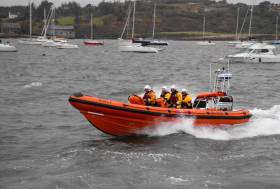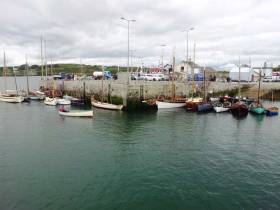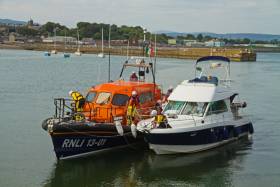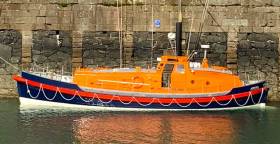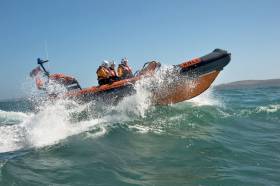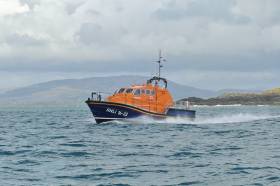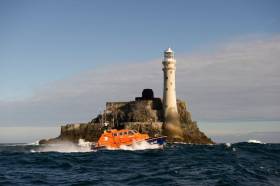Displaying items by tag: Baltimore
A motorboat that became propped up on pot buoys in Baltimore Harbour at the weekend made a direct call for help to the local RNLI’s all-weather lifeboat which was returning to base nearby.
The incident occurred on Saturday evening (7 September) after the Baltimore lifeboat had just completed a training exercise with the Irish Coast Guard’s Waterford-based helicopter Rescue 117.
Lifeboat press officer Kate Callanan said: “The skipper of the motorboat realised immediately that he needed assistance and as he had been watching the lifeboat and helicopter demonstration minutes before, he knew that the quickest way to alert the lifeboat was to call them directly on channel 16 on his VHF.”
Within minutes the all-weather lifeboat — with coxswain Kieran Cotter, mechanic Cathal Cottrell and crew members Emma Lupton, Ronnie Carthy, David Ryan, Jim Griffiths, Ryan O’Mahony and Eoin Ryan — was alongside the 33ft motor vessel.
Another motorboat skippered by former lifeboat crewman Torsten Marten was also nearby at the time, and he was drafted to assist in transferring two lifeboat crew to the casualty vessel rather than having to launch the lifeboat’s Y-boat.
The casualty boat was then secured alongside the all-weather lifeboat and brought to the safety of Baltimore’s North Pier.
Callanan reminded all boaters: “It is vital for anyone going to sea to always carry a means of communication such as a mobile phone or VHF in order to raise the alarm should they require help.”
The callout came on the eve of Baltimore RNLI’s centenary celebration yesterday (Sunday 8 September), at which it named its new Atlantic 85 inshore vessel 100 years to the date since the arrival of its first ever lifeboat.
Elsewhere, Skerries RNLI launched on Thursday night (5 September) to tow a razor fishing boat with two on board that struck rocks off Red Island and damaged its steering.
Baltimore RNLI To Name New Inshore Lifeboat On Centenary Of First Lifeboat’s Arrival
Baltimore RNLI’s new Atlantic 85 lifeboat will be officially named Rita Daphne Smyth during a ceremony at the North Pier at 3pm this Sunday 8 September.
As part of the station’s centenary celebrations, the lifeboat, which was placed on service earlier this year, will be officially named exactly 100 years on from the day the first lifeboat, The Shamrock, arrived in the West Cork coastal village.
The RNLI says the new lifeboat has been funded by a generous legacy from the late Rita Daphne Smyth and replaces the station’s Atlantic 75 class lifeboat Alice and Charles.
The Atlantic 85 is the latest version of the B class, introduced into the fleet in 2005 — powered by two 115HP engines and with a stronger hull and greater top speed.
The self-righting vessel comes with radar and a full suite of communication and and navigation aids, as well as a searchlight, night-vision equipment and flares for night-time operations.
Tom Bushe, Baltimore’s lifeboat operations manager said that to receive and name a new lifeboat during the station’s centenary celebrations was something special.
“Our volunteers and the Baltimore community are delighted and excited to name our new inshore lifeboat exactly 100 years on from the day the very first lifeboat arrived at our station. We are most grateful to the late Rita Daphne Smyth for her generous legacy which has funded our lifeboat.
“Volunteers from the local community have been crewing a lifesaving service here for 100 years and we will be proud custodians of this new lifeboat, which will go on to rescue and save many more lives in the years ahead.”
When Baltimore saw The Shamrock begin service in 1919, it was the fourth lifeboat station in Co Cork. Since then, Baltimore RNLI’s lifeboats have launched more that 940 times and their crews have rescued 867 people including 280 lives saved.
The Shamrock remained in service until 1950 when a new Watson class lifeboat, Sarah Tilson, was placed on service. In 1978, the Sarah Tilson was replaced by another Watson class lifeboat called The Robert, which was replaced six years later was replaced by an Oakley class lifeboat called Charles Henry. In February 1988, a new Tyne class lifeboat, Hilda Jarett, was placed on service.
In April 2008, a second lifeboat, an inshore Atlantic 75 called Bessie, joined the station to complement the existing all-weather lifeboat. In February 2012 a new Tamar class lifeboat, Alan Massey, replaced the Hilda Jarrett.
In July the following year a complete refurbishment of the lifeboat house was finished, leaving the station with state-of-the-art facilities.
Baltimore People Want to Build on Wooden Boats Success
A revival of interest in the traditional working craft of West Cork started in Baltimore in 1997 with the construction of the Noble Shamrock, a 33-foot long mackerel yawl built by Hegarty’s Boatyard at Old Court.
This was done from measurements taken from one of the last surviving hulls of her type, the Shamrock that was built in Baltimore in 1910. Three other craft of this type were built over the next few years.
Traditional 25-foot Heir Island Lobster Boats have also been built. In 1999 the last remaining boat of this type, the Hanora, built in 1893, was rescued, restored by Hegarty’s yard and re-launched in May 2014. Hegarty’s is the yard which restored the ILEN, Ireland’s last trading schooner, that recently sailed to Greenland.
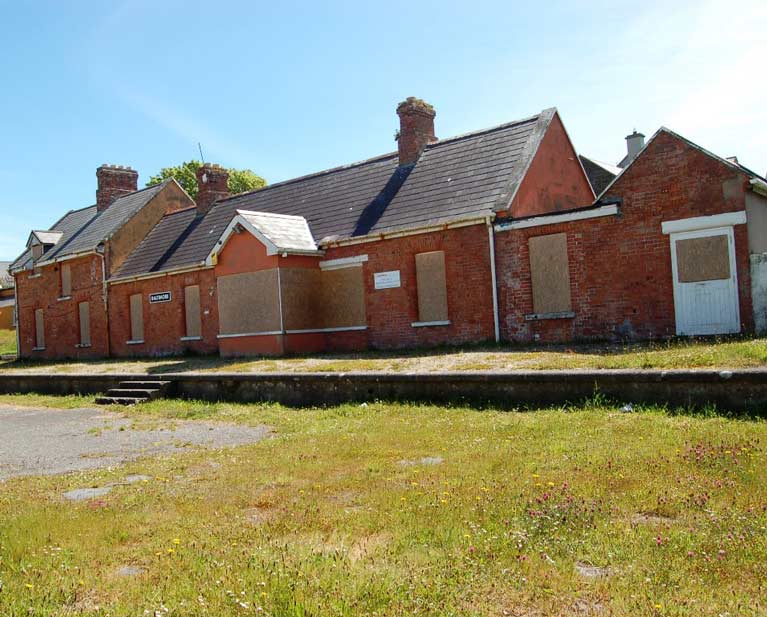 The disused Railway Station at Baltimore
The disused Railway Station at Baltimore
Baltimore Wooden Boat Festival has become a national success. It includes shipwrights and maritime archaeologists amongst its organising committee.
With this has come the plan by CUAS, the West Cork Maritime Heritage Company formed by the village community, to turn the disused former railway station into a Museum of Maritime Heritage, with hands-on activities, teaching traditional boat building and sailing skills, maritime archaeology and rescuing and conserving traditional West Cork craft.
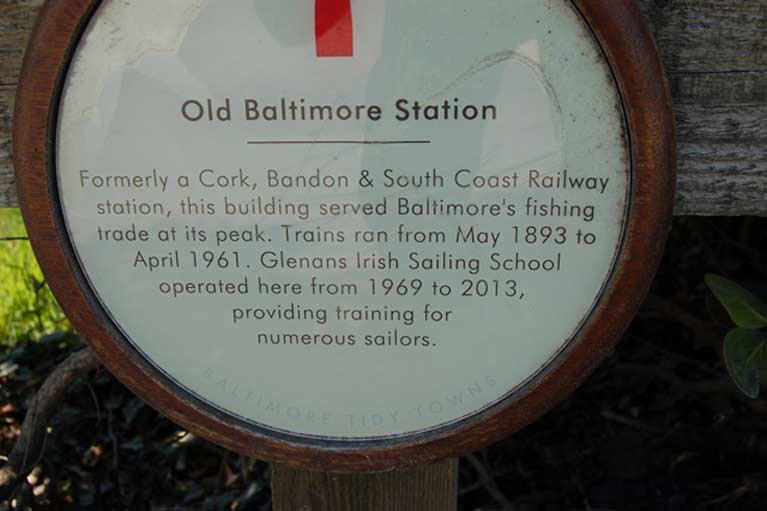 Baltimore Railway Station sign
Baltimore Railway Station sign
That station, a brick building, was once the most southerly railway station in Ireland when it served the thriving fishing village that Baltimore was. It opened in May 1883, but was closed in April 1961.
It was a base for Glenans sailing operation until 2013 but, unused since, has become the target of vandalism.
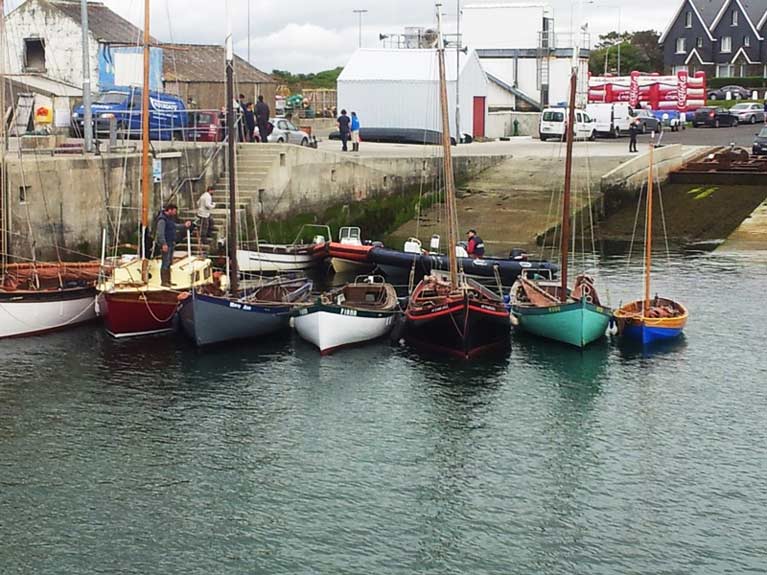 Baltimore Wooden Boats Festival
Baltimore Wooden Boats Festival
It is owned by Failte Ireland, but the local community group is frustrated. At first large amounts of money were being sought for the building. It managed to stop attempts to sell the station, pointing to the benefits which its plan to preserve West Cork’s maritime heritage would have.
Falite Ireland eventually agreed to hand over the building to Cork County Council, with the intention that the community group, CUAS, would turn it into the centre. CUAS says it is confident it can do this. But Fáilte Ireland has still not given a date when it will hand over the building.
A request to Fáilte for information was not answered.
CUAS says they are showing commitment by local people to their area and its maritime heritage in a “determined, positive way”.
It seems time that Fáilte Ireland would respond equally positively.
Wicklow RNLI brought two people and three dogs to safety yesterday afternoon (Saturday 24 August) after their 33ft motor cruiser got fouled in ropes off the Wicklow coast.
The all-weather lifeboat Jock & Annie Slater put to sea shortly at 11am, and 35 minutes later located the stricken Welsh motor cruiser 11 miles north east of Wicklow Harbour.
A towline was established and the cruiser was taken in tow back to Wicklow Harbour, but as they approached the harbour the skipper of the cruiser reported his vessel was taking on water.
As a precaution, the crew prepared a pump and the inshore lifeboat was launched to assist. However, the water was cleared with a bilge pump and the lifeboat pump was not required, Wicklow RNLI says.
It added that the motor cruiser was brought alongside the East Pier shortly before 2pm and the two people and three dogs were landed safely ashore.
Much earlier, Baltimore RNLI in West Cork was called out to a yacht in difficulty south of Sherkin Island.
The inshore lifeboat was launched at 12.31am to assist a 30ft yacht, with two people onboard, that was in difficulty in the Gascanane Sound.
The lifeboat reached the casualty vessel within 20 minutes and found the yacht’s crew to be well before escorting their vessel to the north pier in Baltimore.
They assessed the situation and once the lifeboat crew were happy that the crew on board the vessel were okay, they escorted the vessel to the north pier in Baltimore.
Baltimore RNLI press officer Kate Callanan said: “Although they were not in any immediate danger, the crew of the yacht did the right thing in alerting the coastguard [who tasked the lifeboat].
“At the time of the call there was heavy fog, and the area they were in is notorious for strong tides.
“If you get into difficulty at sea or on the coast, call 999 or 112 and ask for the coastguard.”
Baltimore’s Restored Vintage Lifeboat Will Return to the Scene of the 1979 Fastnet Storm Rescues
It was when the Baltimore Lifeboat was called on the evening of Monday, August 13th 1979 to the assistance of the yacht Regardless that the outside world began to realize that something exceptional was happening to the record 303-boat Fastnet Race fleet writes W M Nixon. With a gathering gale, other yachts were already in difficulties. But as the gale developed into a storm, the call came from Ken Rohan’s Regardless - star boat in the then-winning three-boat Irish Admirals Cup team - that her high-tech carbon fibre rudder stock had broken clean off at sea south of Toe Head.
With one of the most experienced crews of all the boats on board, the fact that Regardless had sought help moved the scenario onto a new level. The Baltimore lifeboat, The Robert, was at sea under Cox’n Christie Collins with a very young Kieran Cotter in her crew, and when she found the disabled Regardless being tossed about like a cork, it took six attempts to get a towline aboard, but after that the fallen star was towed safely into Baltimore, and The Robert put back to sea on other related missions.
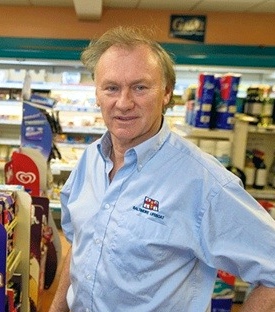 Man of many rescues – the much-decorated Baltimore Lifeboat Cox’n Kieran Cotter at the day job in Baltimore
Man of many rescues – the much-decorated Baltimore Lifeboat Cox’n Kieran Cotter at the day job in Baltimore
Several other lifeboats from along Ireland’s south coast and the boats from St Mary’s in the Isles of Scilly and St Ives on the Cornish mainland, together with helicopters and ships, were also to be involved in the huge rescue effort which saved 132 lives. Yet despite their best efforts, there were to be 19 tragic losses in this exceptional storm, a situation which was to be analysed in several ways – including official reports – in its aftermath.
But gradually life returned to normal, and over the years the recollection of the storm of 1979 has seen the Baltimore Lifeboat, - which had been at sea for longer than any others - becoming the symbol of all the lifeboats involved, a situation which was reinforced when one of her successors, now with Kieran Cotter as Cox’n, played a central role in the rescue of the crew of George David’s super-maxi Rambler 100 when her keel snapped off at the Fastnet Rock in the race of 2011.
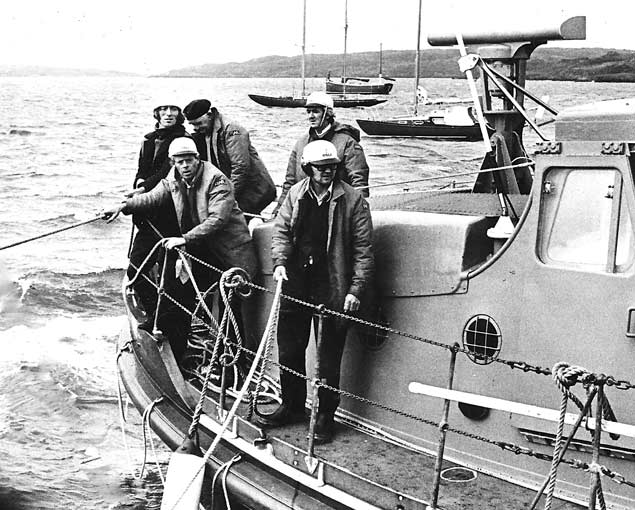 An exhausted Baltimore Lifeboat crew returns to port on completion of their mission in the Fastnet Storm of 1979. They spent the longest time at sea of all the lifeboats on duty in this complex rescue operation
An exhausted Baltimore Lifeboat crew returns to port on completion of their mission in the Fastnet Storm of 1979. They spent the longest time at sea of all the lifeboats on duty in this complex rescue operation
Meanwhile, The Robert, ON 955 and a classic Watson 47, was sliding gently into retirement and obscurity when she was discovered by Jeff Houlgrave. He may be best known on the big boat circuit for his involvement with Marina Projects and as Chairman of Superyacht UK, but one of his intriguing hobbies is the restoration of vintage lifeboats, and with The Robert
he found something very near to his heart.
 The Robert as a cruiser in the early days of her retirement
The Robert as a cruiser in the early days of her retirement
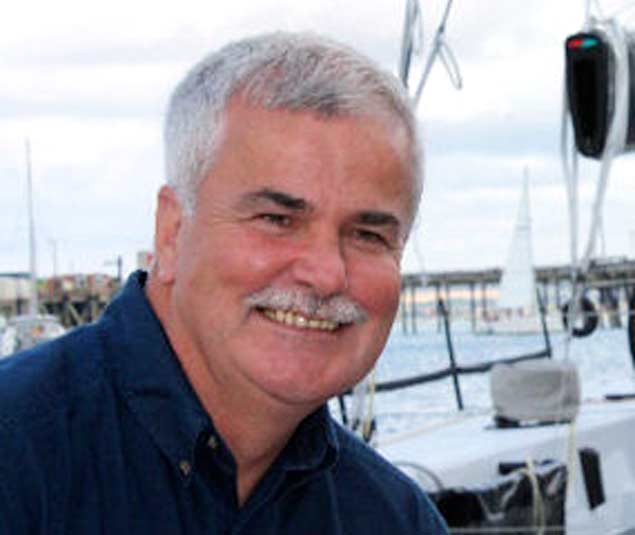 One of Jeff Houlgrave’s individualistic hobbies is the restoration of vintage lifeboats, and The Robert was a very special case
One of Jeff Houlgrave’s individualistic hobbies is the restoration of vintage lifeboats, and The Robert was a very special case
It has to be confessed that when he signalled that this restoration was getting underway last year, the feeling was that time was tight enough to be ready for the big 40th at Baltimore in August. But we were able to put him in touch with Kieran Cotter, still the much-decorated Cox’n of Baltimore Lifeboat, to see what might happen early in August 2019, and last night the signal came through that the superbly restored Robert is now in Crosshaven, and will be heading towards Baltimore on Friday. Clearly, when Jeff Houlgrave gets going on a project, he doesn’t mess about.
With the re-jigging of the international programme such that the Rolex Fastnet Race 2019 start on Saturday 3rd August precedes Cowes Week (10th August – 17th August) for the first time ever, there’s no way any Fastnet racers will be in the region of The Rock on August 13th and 14th, the precise date of the 40th Anniversary of the rescues. But in Baltimore a programme is being developed to reflect the current schedule’s reality while properly respecting the solemn significance of the event.
 Baltimore West Cork – a summer paradise where the links within and between the sailing and lifeboat communities are notably strong. Photo: Tom Vaughan
Baltimore West Cork – a summer paradise where the links within and between the sailing and lifeboat communities are notably strong. Photo: Tom Vaughan
For of all ports, it is Baltimore where the lifeboat crews and the sailing community are most intimately intertwined. Thus in the Beaufort Cup Series within Volvo Cork Week last year, the Lifeboat Service was represented by Baltimore with Deputy Cox’n Youen Jacob skippering their J/109 to such good effect that at times they were leading the very competitive fleet, and at the end it was so close that the theoretical winner, Commandant Barry Byrne with the Defence Forces crew on John Maybury’s J/109 Joker 2, reckoned that as he and his crew were given the choice of which charity their €10,000 prize should go to, they should divide it between the Children’s Hospital and Irish Lifeboats. That’s the way it is in Baltimore.
Baltimore Lifeboat Rescues Windsurfer In Difficulty
Baltimore RNLI launched yesterday afternoon (Wednesday 17 July) to rescue a windsurfer who got into difficulty in Baltimore Harbour in West Cork.
The inshore lifeboat launched at 2.01pm after a member of the public alerted the Irish Coast Guard that a windsurfer was being blown against the shoreline at Reengarogy.
With four volunteer crew aboard — helm Kieran Collins and crew members Micheal Cottrell, David Ryan and Ian Lynch — the lifeboat arrived on scene two minutes later to find the casualty in the water, swimming hard to keep clear of the rocks.
The casualty was brought aboard the lifeboat, along with his board, and once satisfied that he was unharmed, the crew took him back to the beach in Baltimore he had originally set out from.
While the inshore lifeboat crew were dealing with their casualty on the shoreline, instructors from Baltimore Sailing Club went to the assistance of another windsurfer who was in difficulty in the middle of the harbour and brought them safely to shore.
Weather conditions at the time of the call were blustery with a south-westerly Force 5 wind and sloppy sea.
Speaking following the callout, Baltimore lifeboat press officer Kate Callanan said: “This was a particularly fast response as the inshore lifeboat was on scene with the casualty within seven minutes of the lifeboat pagers going off.
“Thankfully a member of the public had spotted the danger that the windsurfer was in and did the correct thing in alerting the coastguard.
“If you see anyone that you think is in difficulty on the water or along the coast, call 999 or 112 and ask for the coastguard.”
Baltimore RNLI launched yesterday morning (Friday 28 June) after a yacht became propped on a pot buoy two miles south of Mizen Head off the coast of West Cork.
The all-weather lifeboat launched at 10.03am following a request by the Irish Coast Guard to assist the 30ft yacht with one person aboard, which had been on passage from Baltimore to Bere Island.
Arriving on scene at 10.47am in misty and foggy conditions with an easterly Force 3-4 wind, the volunteer crew made a quick assessment of the situation, and launched the smaller Y-class lifeboat to try to free the yacht from the pot buoy while the all-weather lifeboat established a tow.
The pot line was cleared within a few minutes, and after the RNLI crew assessed that all was fine with the vessel, the tow was disconnected and the yacht continued on its journey to Bere Island.
Baltimore Lifeboat Called Out Three Times In 24 Hours
The first of three callouts in 24 hours for Baltimore’s RNLI lifeboat volunteers was yesterday morning (Tuesday 25 June), when the all-weather lifeboat was launched to provide medical assistance and evacuation to a man on Cape Clear Island.
The lifeboat arrived at North Harbour in Cape Clear at 11.27am, 20 minutes after launch. The casualty was brought onboard within three minutes and the lifeboat returned to station in Baltimore, handing the casualty over to the care of the waiting HSE ambulance crew at 11.56am.
Baltimore RNLI was called out for a second time in the afternoon to a pleasure boat with engine trouble near the Kedge, east of Baltimore Harbour.
The inshore lifeboat was launched at 3.34pm at the request of the Irish Coast Guard to assist the 31ft pleasure boat, with two onboard, that had broken down east of Kedge Rock which is one mile south-east of the harbour entrance.
The lifeboat, helmed by Kieran Collins with crew members Ian Lynch and David Ryan, reached the casualty vessel at 3.45pm and immediately secured a tow line to its bow.
After confirming the two people onboard were safe and well, they towed the vessel back to its own mooring within Baltimore Harbour.
The third callout came early this morning (Wednesday 26 June) with another medevac, this time from Sherkin Island.
The Baltimore all-weather lifeboat arrived at Sherkin pier at 5.32am, just 10 minutes after launch, and the casualty as brought to the waiting ambulance crew in Baltimore at 5.48am.
Speaking following the callouts, Baltimore RNLI volunteer lifeboat press officer Kate Callanan said: “Our volunteer lifeboat crews are always ready at any time of the day or night to help people in need.
“If you find yourself in difficulty or in need of medical assistance at sea or along the coastline, call 999 or 112 and ask for the coastguard.”
Medevac From Cape Clear Island For Baltimore Lifeboat
Baltimore RNLI carried out a medevac last night (Friday 7 June) from Cape Clear Island off the coast of Baltimore in West Cork.
The volunteer crew launched their all-weather lifeboat at 6.20pm, following a request from the Irish Coast Guard to provide medical assistance and evacuation to an islander living on Cape Clear.
The lifeboat arrived at North Harbour in Cape Clear within 20 minutes, and was headed back to the mainland with the casualty on board after just a two-minute turnaround.
By just after 7pm the casualty had been handed over to the care of a HSE ambulance crew in Baltimore.
Conditions at sea during the call out were good, with a north-westerly Force 4-5 wind, a one-metre sea swell and very good visibility.
Speaking following the callout, lifeboat press officer Kate Callanan said: “If you find yourself in a medical emergency whilst on an island call 999 or 112 and explain to the operator what the nature of the call is.
“The operator will then make sure that the call is directed to both the coastguard and the National Ambulance Service. We wish the casualty a full recovery.
“Our thoughts today are also with the family, friends and colleagues of the crew members of the French lifeboat service SNSM who lost their lives yesterday during a rescue.”
There were seven volunteer crew onboard the lifeboat on this callout: coxswain Kieran Cotter, mechanic Cathal Cottrell and crew members Jerry Smith, Kieran Collins, Pat Collins, Colin Rochford and David Ryan. Assisting at the boathouse in Baltimore were Gerald O’Brien, Aidan Bushe and Don O’Donovan.
Baltimore RNLI rescued two sailors this morning (Thursday 23 May) after their 30ft yacht ran into navigational difficulty at the mouth of the Ilen River in West Cork.
Baltimore RNLI’s all-weather lifeboat under Coxswain Aidan Bushe and with six volunteer crew members onboard was already on the river at 11.10am when it was requested to divert to the scene and go to the sailors' aid.
The yacht was on passage to Baltimore when the sailors got into difficulty and the vessel ran aground on rocks in strong tidal conditions.
Weather conditions were otherwise good at the time with clear visibility, a smooth sea state and a light to light westerly wind.
Once on scene, the lifeboat crew checked that the sailors were safe and well before working with them to set up a tow line. The lifeboat proceeded to pull the yacht off the rocks and after checking that the boat was not damaged and that the sailors could make their way to Baltimore unaided, the lifeboat departed the scene.
Speaking following the call out, Baltimore Coxswain Aidan Bushe said: ‘Even the most experienced sailors can get into difficulty and we were happy to be of assistance to the yacht’s crew this morning. As we approach the summer, we would remind people of the importance of knowing their buoyage. Knowing your sea marks can mean the difference between having a good day out or running into problems.
‘Regardless of activity, we would remind everyone to respect the water. Always wear a lifejacket and always carry a means of calling for help. Check the weather forecast and tide times and make sure someone ashore knows where you are going and what time you are due back. Should you get into difficulty, call 999 or 112 and ask for the Coast Guard.’



























